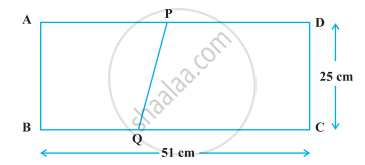Advertisements
Advertisements
Question
Find the area of ΔABC with A(1, -4) and midpoints of sides through A being (2, -1) and (0, -1).
Solution
Let ( x2, y2) and (x3, y3) be the coordinates of B and C respectively. Since, the coordinates of A are (1,-4) , therefore
`(1+x_2)/2= 2⇒x_2 = 3`
`(-4+y_2)/2=-1⇒y_2 = 2`
`(1+x_2)/2 =0⇒x_3=-1`
`(-4+y_3)/2 = -1 ⇒ y_3 = 2`
` " let " A (x_1,y_1) = A (1,-4) , B (x_2,y_2) = B(3,2) and C(x_3,y_3) = C (-1,2) Now`
`"Area " (Δ ABC) = 1/2 [x_1(y_2-y_3) +x_2 (y_3-y_1)+x_3(y_1-y
_2)]`
`=1/2 [1(2-2)+(2+4)-1(-4-2)]`
`=1/2[0+18+6]`
=12 sq. units
Hence, the area of the triangle ΔABCis 12 sq. units
APPEARS IN
RELATED QUESTIONS
If P(–5, –3), Q(–4, –6), R(2, –3) and S(1, 2) are the vertices of a quadrilateral PQRS, find its area.
For what value of x will the points (x, –1), (2, 1) and (4, 5) lie on a line ?
If the coordinates of two points A and B are (3, 4) and (5, – 2) respectively. Find the coordniates of any point P, if PA = PB and Area of ∆PAB = 10
The coordinates of A, B, C are (6, 3), (–3, 5) and (4, – 2) respectively and P is any point (x, y). Show that the ratio of the areas of triangle PBC and ABC is
ABCD is a rectangle formed by the points A(-1, -1), B(-1, 4), C(5, 4) and D(5, -1). P, Q, R and S are the midpoints of AB, BC, CD and DA respectively. Is the quadrilateral PQRS a square? a rectangle? or a rhombus? Justify your answer.
Find the area of the following triangle:

Find the value of x for which points A(x, 2), B(-3, -4) and C(7, -5) are collinear.
If `D((-1)/2, 5/2), E(7, 3)` and `F(7/2, 7/2)` are the midpoints of sides of ∆ABC, find the area of the ∆ABC.
The dimensions of a rectangle ABCD are 51 cm × 25 cm. A trapezium PQCD with its parallel sides QC and PD in the ratio 9 : 8, is cut off from the rectangle as shown in the following figure. If the area of the trapezium PQCD is `5/6` th part of the area of the rectangle, find the lengths QC and PD.

Let a vector `αhati + βhatj` be obtained by rotating the vector `sqrt(3)hati + hatj` by an angle 45° about the origin in counter-clockwise direction in the first quadrant. Then the area of triangle having vertices (α, β), (0, β) and (0, 0) is equal to ______.
